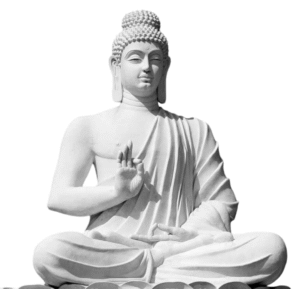Vitarka Mudra
Introduction
Vitarka Mudra is a classical hand gesture in yoga and Buddhist iconography that symbolizes discussion, intellectual argument, and transmission of wisdom. It is widely used in meditation, teaching, and energy work to enhance mental clarity, focus, and communication of ideas.
The term comes from Sanskrit:
Vitarka: Discussion, reasoning, or intellectual argument
Mudra: Hand gesture or seal
Overall Purpose:
Vitarka Mudra stimulates mental clarity, intellectual focus, and energetic flow to the upper body and head, supporting learning, teaching, and communication.
Meaning
Vitarka: Intellectual debate, reason, and logical discussion.
Mudra: A symbolic hand gesture used to direct prana and consciousness.
Overall Meaning:
Vitarka Mudra channels energy to promote wisdom, mental clarity, reasoning, and the ability to communicate ideas effectively.
How to Perform / Practice
POSTURE GUIDE
To attain Vitarka mudra curl the index finger to touch its tip with the thumb keeping the remaining fingers extended upward. The index finger and thumb are joined to form a circle and the palm is facing forward away from the body. It opens one’s mind and spirit to gain spirituality.
Benefits
Physical Benefits:
Enhances circulation to the upper limbs, neck, and brain.
Improves hand and finger dexterity.
Supports respiratory and endocrine system function through meditative focus.
Mental & Emotional Benefits:
Stimulates mental clarity, focus, and reasoning ability.
Reduces mental fatigue, confusion, and stress.
Supports confident communication and teaching abilities.
Energetic / Spiritual Benefits:
Channels prana to the head and chest, enhancing intellectual and spiritual energy.
Encourages wisdom, insight, and higher awareness.
Supports meditative absorption and energy flow to the crown and throat chakras.
Contraindications
Avoid if experiencing hand or finger injuries.
Not recommended for severe arthritis or joint pain in fingers.
Discontinue if discomfort, numbness, or tingling occurs.
Practice moderately if experiencing overstimulation of the mind or restlessness.
Anatomy & Physiology
Muscles: Engages intrinsic hand muscles (lumbricals, interossei) and forearm muscles to maintain finger positions.
Joints: Flexion at thumb and index finger; extension at middle, ring, and little fingers.
Nervous System: Activates parasympathetic pathways, promoting calm mental focus.
Circulation: Enhances blood flow in hands, arms, and indirectly to the head, improving energy and oxygen supply.
Kinesiology
Enhances fine motor coordination and static postural control.
Supports hand stability during seated meditation.
Encourages relaxed hand and finger posture, aiding mental clarity and pranic flow.
Neurology
Stimulates brain regions associated with attention, learning, and intellectual processing.
Balances sympathetic and parasympathetic activity, reducing cognitive fatigue and mental stress.
Supports neural pathways for focus, reasoning, and communication.
Duration of Practice
Daily Practice: 10–20 minutes during meditation, study, or teaching.
Short Practice: 5 minutes for quick mental clarity or focus.
Can be combined with Dhyana Mudra or Chin Mudra for deeper meditative absorption.
Counter Mudra
If mental fatigue occurs, relax hands in Gyan Mudra or Prithvi Mudra.
Gentle hand stretching or shaking is recommended after long practice.
Conclusion
Vitarka Mudra is a powerful hand gesture for enhancing wisdom, mental clarity, and communication. Regular practice supports intellectual focus, emotional balance, and pranic flow, making it ideal for meditation, study, teaching, and spiritual development.
FAQ
Q1: Can beginners practice Vitarka Mudra?
A: Yes, it is simple and safe; start with a few minutes and gradually increase.
Q2: Can it improve focus and reasoning?
A: Yes, it stimulates mental clarity, attention, and intellectual energy.
Q3: Can it be combined with other mudras?
A: Yes, it pairs well with Dhyana Mudra, Chin Mudra, or Vishuddha Mudra for enhanced meditative and cognitive benefits.
Q4: Is it suitable for teaching or meditation?
A: Yes, it enhances intellectual focus, energy, and communication skills.
References
Swami Satyananda Saraswati, Mudras for Healing and Transformation.
Iyengar, B.K.S., Light on Yoga.
Saraswati, S., Pranayama and Mudras in Yoga Therapy.
Fishman, L., Yoga for Emotional Balance.
Lad, V., Ayurveda: The Science of Self-Healing.
Journal of Bodywork and Movement Therapies, 2018; 22(4): Effects of Hand Mudras on Mental and Physiological Functions.

